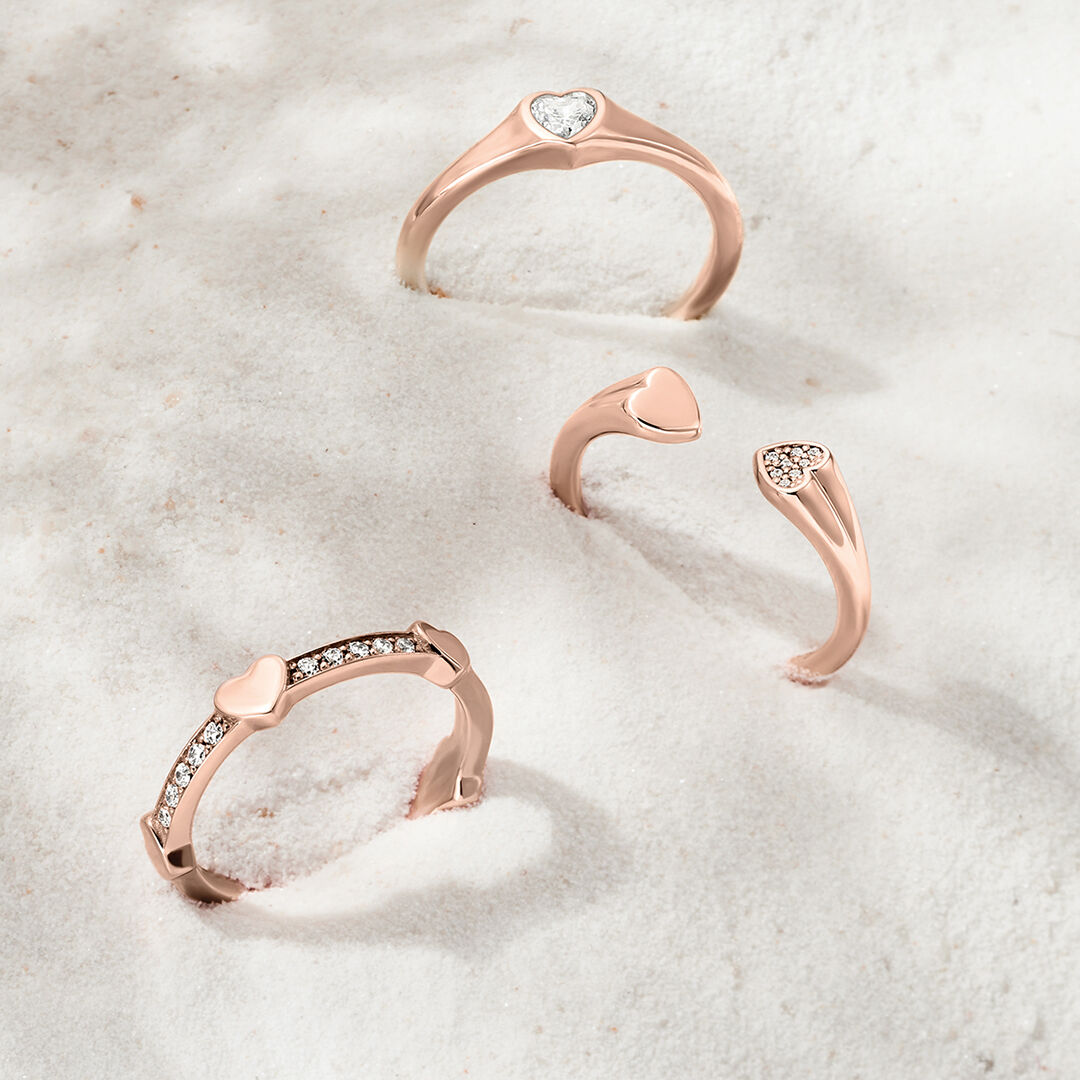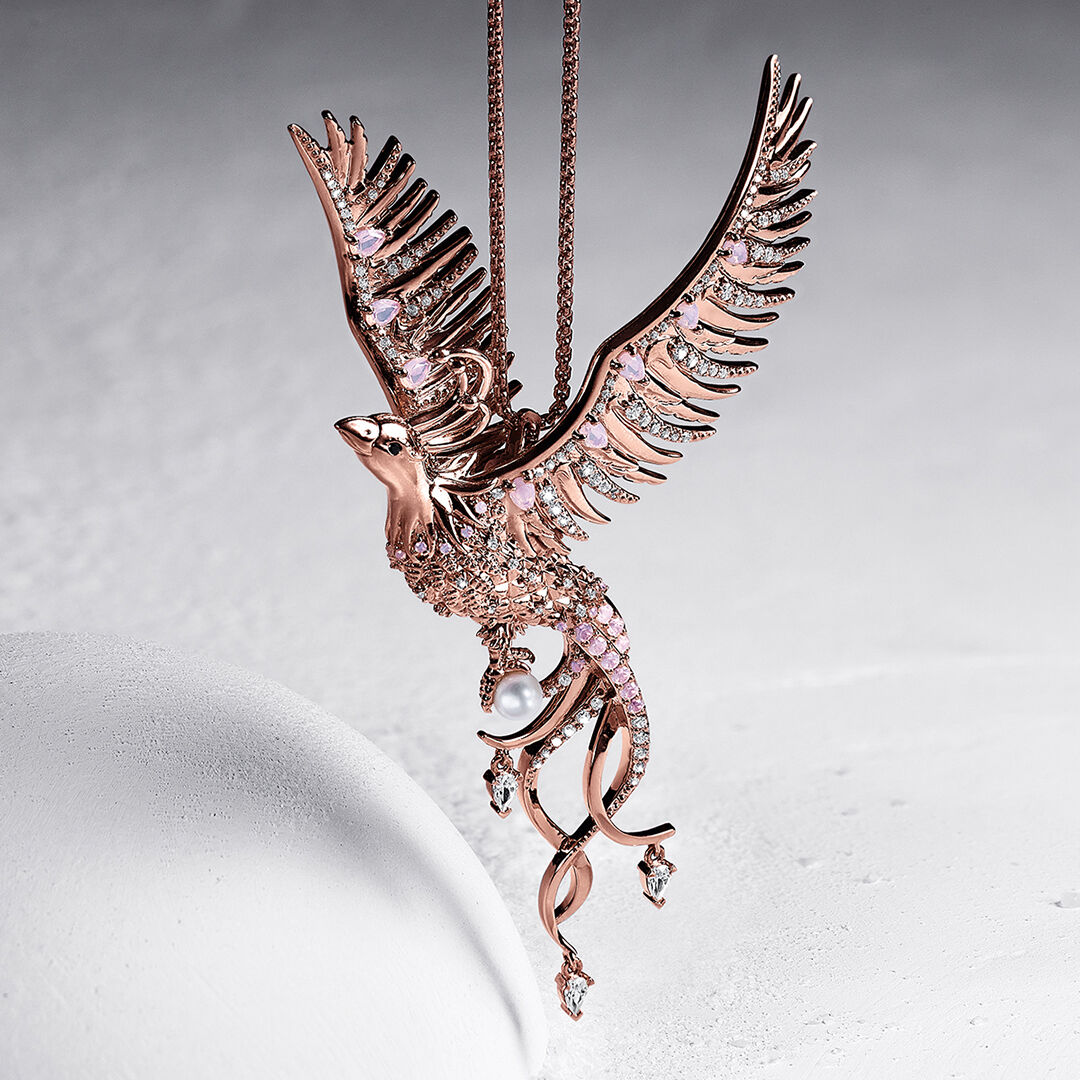
What is rose gold?
Rose gold is a gold alloy that is made of real gold and other precious metals. Pure gold has a yellow golden colour and is quite soft. To work it better, other metals are admixed to it. These include:
- silver
- copper
- palladium
- platinum
- zinc
- nickel
The alloys ensure the gold’s higher degree of hardness and firmness. On the other hand, its characteristic colour can be changed, too. Rose gold is obtained when a certain amount of copper is admixed to the precious metal. The bigger the amount the more reddish the colour of the gold alloy will result. Depending on this alloy, the resulting alloy is a soft rose gold or a bolder red gold. THOMAS SABO uses a rather delicate nuance for their designs that perfectly fit the iconic designs with zirconia stones. In addition, it can be combined with our jewellery made of 925 sterling silver as well as 18k yellow gold plating.
How high-quality is rose gold?
As for all other gold alloys, the same goes for rose gold: its quality and value depends on the gold content. The higher the latter, the higher the quality and the higher the price. The fine gold content is measured in thousandth parts. As for 585 rose gold, 585 parts are pure gold, and the remaining 415 parts are other metals like copper and silver. The ratio depends on the desired colour. If the rose gold should result soft pinkish, the silver content will be higher than the copper content.
One of the highest quality alloys is 18k rose gold that has a fine gold percentage of 75 %. A copper percentage of 16 and 9 % of silver are admixed. THOMAS SABO jewellery is created with 18k rose gold only.
What does carat mean with regards to rose gold?
In the US as well as the Middle East and in Asian countries, the gold content in alloys is measured in carat.
- 333 rose gold: 8k rose gold
- 375 rose gold: 9k rose gold
- 585 rose gold: 14k rose gold
- 750 rose gold: 18k rose gold
What about rose gold-plated jewellery?
High-quality rose gold like 18k rose gold has a pretty high price. In order to create jewellery with this alloy, gold plating is a good option. This entails that pieces of jewellery made of 925 Sterling silver are gold-plated with rose gold – either mechanically or by means of a chemical process.
Jewellery can be refined with different gold alloys, for example with 18k rose gold. Most of the designs in our THOMAS SABO portfolio are rose gold-plated. With the exceptional fine jewellery in our Fine Jewellery Collection we also offer a wide range of rings, necklaces and bracelets made of real 18k rose gold.
Why is rose gold so popular?
For many years now, the soft pink gold alloy has been a big trend, thus our selection of jewellery for women that comes in this colour is wide. The reason lies in the strong appeal rose gold exudes, since its hue is a mixture between silver, white and yellow gold. Due to its warm colour, rose gold is just as attractive as gold, yet looks more subtle and softer. Rose gold exudes glamour and looks modern at the same time – it is comparable to a soft blush that instantly makes you look fresher. Furthermore, rosé is a very feminine colour and very attractive to women who like to accentuate their femininity. For playful designs rose gold is also a great choice. Minimalistic jewellery is also created with the pinkish alloy and brings the pink colour to the forefront.
How do I care for rose gold jewellery?
When wearing necklaces, bracelets, ear jewellery and rings in rose gold, different substances can build up on their surfaces. Dust, dirt, creams, perfume, or hairspray – these can build up and reduce gold jewellery’s surface shine or induce its discolouration. This is why we advise you to clean your rose gold jewellery from time to time.
- Remove light dirt with lukewarm water and a soft cloth.
- Add some mild dish soap to dissolve fat and dirt.
- In order to remove heavy dirt, soak your rose gold jewellery in a mixture of lukewarm water and dish soap for a few minutes.
- Rinse your pieces of jewellery with clear water.
- Dry off properly with a soft, lint-free towel.
- Use a jewellery care cloth to polish smooth surfaces and enhance their radiant shine.
Does rose gold tarnish?
Compared to silver pure gold does not oxidize, since it does not have the same properties. Yet, alloys oftentimes contain silver, which can lead to an oxidation and discolouration process if the silver content is very high. This is why rose gold can also tarnish but not as much as silver. If the gold content is very high as is the case of 18k rose gold, the surface can tarnish a bit.
Copper contributes to the material’s colour and hardness since it ranks among the hardest metals. This is one of the reasons why it is regularly used and processed in manufacturing, for example for electrical conductors as well as for train and car manufacturing. Therefore, necklaces, bracelets, earrings and rings for women made of rose gold are characterised by their great durability. It is possible that they darken over the years since copper can get slightly darker. This provides the vintage look and special charm that is typical of rose gold jewellery.

.jpg?sfrm=jpg)
Does rose gold tarnish?
Compared to silver pure gold does not oxidize, since it does not have the same properties. Yet, alloys oftentimes contain silver, which can lead to an oxidation and discolouration process if the silver content is very high. This is why rose gold can also tarnish but not as much as silver. If the gold content is very high as is the case of 18k rose gold, the surface can tarnish a bit.
Copper contributes to the material’s colour and hardness since it ranks among the hardest metals. This is one of the reasons why it is regularly used and processed in manufacturing, for example for electrical conductors as well as for train and car manufacturing. Therefore, necklaces, bracelets, earrings and rings for women made of rose gold are characterised by their great durability. It is possible that they darken over the years since copper can get slightly darker. This provides the vintage look and special charm that is typical of rose gold jewellery.
Just like silver rings and necklaces made of silver, you can polish your jewellery with rose gold-plating with a silver cleaning cloth. This will remove discolouration. For designs with stone embellishment and rich ornamentation like dots, cut-outs and engravings, a jewellery care bath will be a much better option.
- Briefly soak your pieces of jewellery in the cleaning solution.
- Rinse it with clear water.
- Dry off properly with a soft cloth or put it on a towel and allow it to dry completely.
- Polish your rose gold-plated jewellery with a jewellery care cloth.
Please follow the instructions for use when using cleaning products. In general, you should be careful when cleaning rose gold jewellery with stones. Zirconia and diamonds are usually pretty resistant when they come into contact with cleaning products. This does not apply to rose quartz , jasper, lapis lazuli and other stones as well as pearls and mother-of-pearl.
If you are unsure when it comes to cleaning your jewellery, you can use our comprehensive treatment service at THOMAS SABO. For an additional fee, our experts clean and polish your rose gold jewellery and rose gold-plated jewellery in our in-house workshops. This preserves their beauty and ensures that you will be able to enjoy and wear them for a long time.
Further details regarding our high-quality rose gold-plating at THOMAS SABO
- Our rose gold-plated pieces of jewellery made of 925 sterling silver
- we use 18k respectively 750 rose gold
- gold alloy: fine gold is mixed with other metals that add a higher degree of hardness
- the resistant gold layer protects the underlying 925 Sterling silver
- additional tarnish protection since rose gold can tarnish a bit
- several µ gold-plating layers – higher above average layer thickness compared to market standard, thin gold-plating
- stronger gold-plating for usually heavily used pieces of jewellery like rings and bracelets
- for an additional fee, reconditioning and re-plating of THOMAS SABO jewellery with rose gold-plating is a great option.
